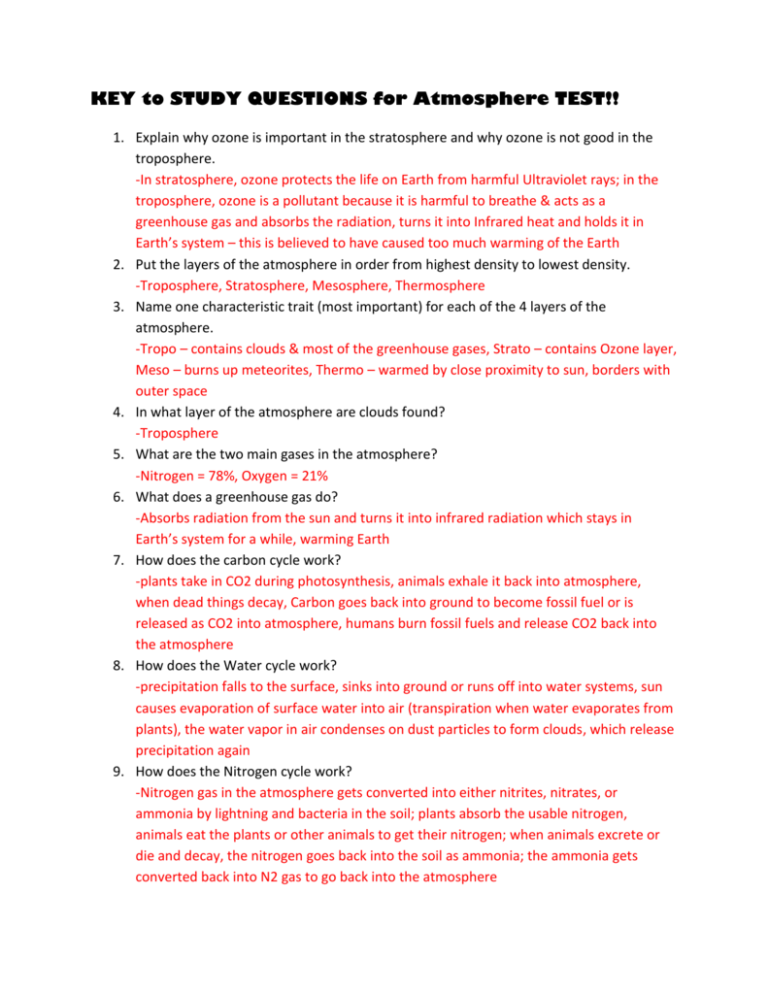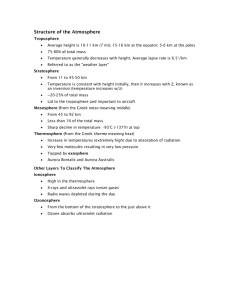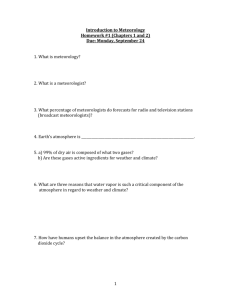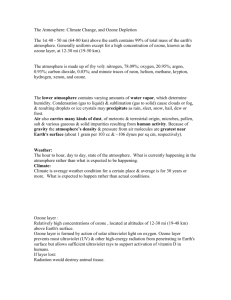STUDY QUESTIONS for Atmosphere TEST KEY
advertisement

KEY to STUDY QUESTIONS for Atmosphere TEST!! 1. Explain why ozone is important in the stratosphere and why ozone is not good in the troposphere. -In stratosphere, ozone protects the life on Earth from harmful Ultraviolet rays; in the troposphere, ozone is a pollutant because it is harmful to breathe & acts as a greenhouse gas and absorbs the radiation, turns it into Infrared heat and holds it in Earth’s system – this is believed to have caused too much warming of the Earth 2. Put the layers of the atmosphere in order from highest density to lowest density. -Troposphere, Stratosphere, Mesosphere, Thermosphere 3. Name one characteristic trait (most important) for each of the 4 layers of the atmosphere. -Tropo – contains clouds & most of the greenhouse gases, Strato – contains Ozone layer, Meso – burns up meteorites, Thermo – warmed by close proximity to sun, borders with outer space 4. In what layer of the atmosphere are clouds found? -Troposphere 5. What are the two main gases in the atmosphere? -Nitrogen = 78%, Oxygen = 21% 6. What does a greenhouse gas do? -Absorbs radiation from the sun and turns it into infrared radiation which stays in Earth’s system for a while, warming Earth 7. How does the carbon cycle work? -plants take in CO2 during photosynthesis, animals exhale it back into atmosphere, when dead things decay, Carbon goes back into ground to become fossil fuel or is released as CO2 into atmosphere, humans burn fossil fuels and release CO2 back into the atmosphere 8. How does the Water cycle work? -precipitation falls to the surface, sinks into ground or runs off into water systems, sun causes evaporation of surface water into air (transpiration when water evaporates from plants), the water vapor in air condenses on dust particles to form clouds, which release precipitation again 9. How does the Nitrogen cycle work? -Nitrogen gas in the atmosphere gets converted into either nitrites, nitrates, or ammonia by lightning and bacteria in the soil; plants absorb the usable nitrogen, animals eat the plants or other animals to get their nitrogen; when animals excrete or die and decay, the nitrogen goes back into the soil as ammonia; the ammonia gets converted back into N2 gas to go back into the atmosphere 10. How is radiation different than conduction? -radiation is receiving waves of energy from a source; conduction is heat energy being passed through direct contact from a surface that has received radiation to another surface or area 11. How is convection related to density? -warmer air expands, becomes less dense and rises, cooler air is more dense and will sink to be reheated by Earth’s surface, this causes the movement of air or a liquid known as convection 12. How is convection related to temperature? -air above the surface of Earth gets heated by conduction, the particles move more rapidly & spread out, the warm/less dense air rises; this pushes the cooler/more dense air to sink as particles cool off, slow down, and get closer together 13. Explain the greenhouse effect. -greenhouse gases absorb the sun’s radiation and turn it into Infrared rays that circulate within the atmosphere before leaving it, heat is held into Earth’s system longer than it would be without the greenhouse gases 14. Describe particulates in the air & their negative side effects. -dust, pollen, ash, dirt, salt; they can irritate eyes, nose, throat, lungs, make it difficult to see or breathe, can cause health problems, can damage plants & outdoor surfaces, can affect weather 15. Name some effects of air pollution. -acid rain damages statues & buildings, health problems, smog over cities, can harm water systems, etc. 16. Describe why many scientists are concerned about the build-up of greenhouse gases in the atmosphere. -more greenhouses gases than can be naturally removed from atmosphere more absorption of radiation and conversion to Infrared rays which keeps heat in atmosphere longer and is causing Earth’s average temperatures to increase this global warming would cause melting of glaciers/ice caps, rising of ocean waters, flooding on coastlines, and upset to ecosystems










